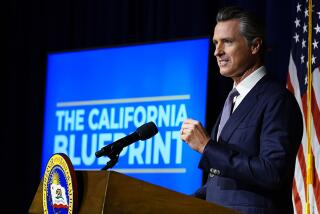An older, bolder Jerry Brown deserves kudos for his budget plan
From Sacramento — It’s a different Gov. Jerry Brown we’re seeing these days — a subtle but significant difference between Brown I and Brown II.
The Brown who was governor at age 36 would not have been as bold — as calmly willing to stick his neck way out — as the 72-year-old version.
The contrast—along with a stark stylistic difference between Brown and predecessor Arnold Schwarzenegger — was evident at a news conference Monday. The new governor unveiled his cuts-taxes-and-shuffle remedy for closing a projected $25.4-billion budget hole.
“I loved the fact that he stood up for 46 minutes and deftly explained the complexities of California’s budget,” says political attorney Steve Merksamer, a longtime Sacramento insider who was chief of staff to former Republican Gov. George Deukmejian.
Schwarzenegger just didn’t have the grasp of detail that the career pol Brown has, although the Hollywood transplant acted as if he did.
Schwarzenegger always held his annual budget news conferences in a large theater-like auditorium in the secretary of state’s building. One entire section would be filled with political appointees and lawmakers. They’d rise and loudly applaud as the governor walked on stage with a flourish, as if he were gliding onto “The Jay Leno Show.”
Brown, on the other hand, used the small Capitol news conference room that basically hasn’t changed since his father was governor 45 years ago. He drew about as many TV cameras and reporters as Schwarzenegger ever did, but there was no cheering section of star-struck minions. Brown’s wife and a few aides stood quietly along a wall.
What I particularly noticed was the contrast in styles of a circus barker and a calm physician.
Schwarzenegger was always pitching, promising cure-all budget remedies such as a rainy-day fund. The scary thing was he actually seemed to believe that what he was selling was the total solution to red ink.
Brown was like an old physician calmly prescribing pills and pain. If the patient didn’t want to undergo the treatment, well, that’s no skin off his nose. The patient’s condition would get worse. The doc’s life would go on.
“It is better to take our medicine now and get the state on a balanced footing,” Brown told reporters.
Standing nearby was Tom Quinn, a Brown confidant and strategist for 40 years.
Later, I remarked that Brown seemed rather fatalistic and matter-of-fact.
“He has as much to lose as everybody else in California” if the state doesn’t soon start operating in the black, Quinn said. “And everybody else has as much to lose as he does.
“If the people in California want to dismantle more and more and more, they’ll get what they want. He prefers not to see that happen. And he’s going to do all he reasonably can to explain why it’s important that people accept his solutions.
“But the people will make the decision. And if the vote goes against him, he’s prepared to accept it.”
Or, as Brown said at the news conference: “This is a democracy. People get to [decide] what they want….I’m just going to lay out the facts and whatever they decide is going to be the result.”
Brown is prescribing a lot of pain: Sharp spending cuts in health and welfare, universities and parks. He wants to extend for five more years temporary increases in income, sales and car taxes. And he proposes shuffling some state responsibilities to local governments, paying for them with tax extensions.
The cuts and taxes are bound to be unpopular. The shuffling is sure to conjure suspicion.
I asked Quinn whether Brown would have attempted such a risky venture 35 years ago when he was looking in the mirror and seeing a president. “Probably not,” he answered. “Probably neither would have anyone else who has been governor.”
Some critics have complained that Brown’s proposals aren’t bold enough — that the realignment of state and local responsibilities should involve more than a few public safety, mental health, foster care and child welfare programs. But they total nearly $6 billion.
Brown, understanding that politics is the art of the possible, thinks he’ll be fortunate to get that much passed by the Legislature and approved by voters. Already, there’s a big stink about his proposal to eliminate redevelopment agencies.
Some also criticize Brown for essentially letting K-12 schools and prisons off the hook. Everyone should sacrifice, they harp.
But the protection of schools and prisons from pain is largely about strategy. The argument for tax extensions is being framed to sound like this: Vote for the taxes or many schools will need to be closed and thousands of prisoners will have to be released.
You probably won’t hear Brown trying to scare people with that warning. He knows that voters are suspicious of anything politicians say and are offended by threats.
Let the editorial writers issue those warnings — as well as the teachers and prison guards’ unions. They’ll be highly motivated to help bankroll the “yes on taxes” campaign heading into a June election.
If there is one, that is. If enough Republicans will vote to place the question before the electorate. So far there’s no sign of that.
Republicans essentially are echoing the attitude of Sen. Tom Berryhill (R-Modesto), who told reporters after the GOP Caucus met privately with Democrat Brown on Tuesday: “This is really not our problem. The Democrats own this.”
Could have fooled me. I thought it was all of California’s problem.
More to Read
Get the L.A. Times Politics newsletter
Deeply reported insights into legislation, politics and policy from Sacramento, Washington and beyond. In your inbox three times per week.
You may occasionally receive promotional content from the Los Angeles Times.











